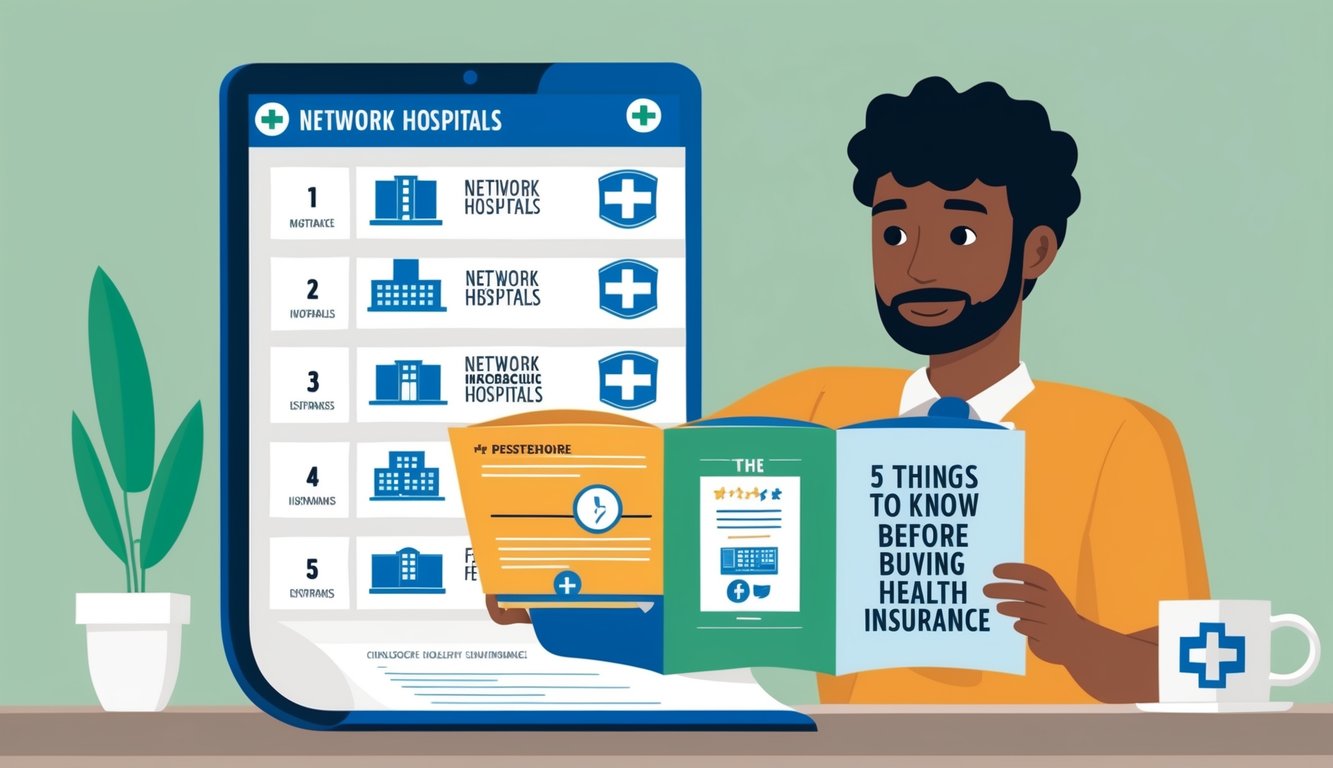Choosing the right health insurance can be a daunting task.
With numerous options available, you need to understand the key factors that will impact your coverage and costs.
Taking the time to research and compare plans can save you money and ensure you have the protection you need.
Before selecting a health insurance plan, there are five essential things you should know. These factors will help you make an informed decision that aligns with your healthcare needs and financial situation.
By considering these key points, you’ll be better equipped to navigate the complex world of health insurance and choose a plan that provides the best value for you and your family.
1) Understand Policy Terms
Before purchasing health insurance, make sure to familiarize yourself with key policy terms.
These terms will help you better comprehend your coverage and make informed decisions.
Premium is the amount you pay regularly to maintain your insurance coverage.
This payment is typically made monthly, quarterly, or annually.
Deductible refers to the amount you must pay out-of-pocket for covered services before your insurance starts to contribute. Higher deductibles often result in lower premiums.
Copayment, or copay, is a fixed amount you pay for certain services or medications.
This is usually due at the time of service.
Coinsurance is the percentage of costs you share with your insurance company for covered services after meeting your deductible.
Out-of-pocket maximum is the most you’ll have to pay for covered services in a plan year.
Once you reach this limit, your insurance will cover 100% of eligible expenses.
Network refers to the healthcare providers and facilities that have agreements with your insurance company. In-network care is typically less expensive than out-of-network care.
Exclusions are specific treatments, conditions, or services that your policy doesn’t cover.
It’s important to review these carefully to avoid unexpected costs.
Understanding these terms will help you compare plans effectively and choose the one that best fits your healthcare needs and budget.
2) Check Network Hospitals

When selecting a health insurance plan, it’s crucial to examine the network of hospitals and healthcare providers.
Your plan’s network determines where you can receive care at in-network rates.
Start by reviewing the list of in-network hospitals associated with each plan you’re considering.
Verify that your preferred hospitals and medical centers are included.
Consider the proximity of in-network hospitals to your home and workplace.
In case of emergencies or ongoing treatments, having nearby options can be invaluable.
Check if specialized hospitals or treatment centers are part of the network, especially if you have specific health concerns.
This ensures access to specialized care without incurring higher out-of-network costs.
Be aware that some plans may have narrow networks with fewer hospital options.
While these plans often have lower premiums, they limit your choices for care.
If you travel frequently, look for plans with broad networks or coverage for out-of-area hospital care.
This can provide peace of mind when you’re away from home.
Remember that using out-of-network hospitals typically results in higher out-of-pocket costs.
Always verify a hospital’s network status before seeking non-emergency care.
3) Know About Waiting Periods
When purchasing health insurance, make sure to understand waiting periods.
A waiting period is the time you must wait before certain benefits of your policy become active.
Most health insurance plans have waiting periods for specific conditions or treatments.
These can range from a few months to several years, depending on the policy and the insurer.
For pre-existing conditions, waiting periods are often longer.
You may need to wait 2-4 years before your policy covers treatment for these conditions.
Some policies have waiting periods for maternity benefits, typically lasting 9-36 months.
It’s important to plan ahead if you’re considering starting a family.
Certain surgeries or procedures might also have waiting periods.
These can include treatments for joint replacements, hernias, or cataracts.
Workplace health insurance plans may impose waiting periods before coverage begins.
This can range from 30 to 365 days after you start your new job.
Understanding waiting periods helps you plan your healthcare needs effectively.
It allows you to anticipate when you’ll be able to claim benefits for specific conditions or treatments.
Before signing up for a policy, carefully review the waiting period terms.
Ask your insurance provider for clarification if anything is unclear.
Remember, you can’t wait until you’re sick to buy insurance.
Purchasing coverage during open enrollment periods is essential to ensure you’re protected when you need it.
4) Compare Premium Costs

When choosing health insurance, comparing premium costs is crucial.
Premiums are the monthly payments you make to maintain your coverage.
Lower premiums may seem attractive, but they often come with higher out-of-pocket costs.
Consider your budget and health needs when evaluating premiums.
Health insurance plans are categorized into metal tiers: Bronze, Silver, Gold, and Platinum.
Bronze plans typically have lower premiums but higher out-of-pocket costs.
Platinum plans have higher premiums but lower out-of-pocket expenses.
Silver and Gold plans fall in between, offering a balance of premium costs and coverage.
Your age, location, and tobacco use can affect premium costs.
Younger individuals generally pay lower premiums, while smokers may face higher rates.
Don’t forget to check if you qualify for subsidies or tax credits.
These can significantly reduce your premium costs, making higher-tier plans more affordable.
When comparing plans, look beyond the premium.
Consider deductibles, copayments, and coinsurance to get a complete picture of your potential costs.
Some plans offer Health Savings Account (HSA) compatibility.
These accounts allow you to save money tax-free for medical expenses, potentially offsetting higher premiums.
Remember, the cheapest plan isn’t always the best value. Evaluate the benefits offered alongside the premium costs to find the right balance for your needs.
5) Review Coverage Options
When selecting health insurance, carefully examining coverage options is crucial.
You’ll want to compare the scope of services offered by different plans.
Look at the list of covered medical services, procedures, and treatments.
Pay attention to preventive care, specialist visits, hospital stays, and prescription drug coverage.
Check if the plans cover services you anticipate needing, such as maternity care or mental health treatment.
Some plans may offer broader coverage than others.
Consider any chronic conditions or ongoing health needs you have.
Ensure the plan adequately covers related treatments and medications.
Examine the network of healthcare providers.
Verify if your preferred doctors and hospitals are in-network to avoid higher out-of-pocket costs.
Review coverage limits and exclusions.
Some plans may have restrictions on certain treatments or cap the number of covered visits for specific services.
Don’t forget to assess prescription drug coverage.
Check if your current medications are on the plan’s formulary and at what tier level.
Consider any additional benefits offered, such as dental or vision coverage.
These can provide valuable extra protection for your overall health.
Evaluate coverage for emergency services and out-of-network care.
This is especially important if you travel frequently or live in an area with limited in-network options.
Understanding Health Insurance Plans
Health insurance plans can be complex, but knowing the basics will help you make an informed decision.
Familiarizing yourself with plan types and key terms is essential for choosing coverage that fits your needs and budget.
Types of Health Insurance Plans
Health Maintenance Organization (HMO) plans offer lower costs but restrict you to in-network providers.
You’ll need a primary care physician referral for specialists.
Preferred Provider Organization (PPO) plans provide more flexibility.
You can see out-of-network doctors, but at a higher cost.
No referrals are needed for specialists.
Exclusive Provider Organization (EPO) plans combine features of HMOs and PPOs.
You’re limited to in-network providers, but don’t need referrals.
Point of Service (POS) plans blend HMO and PPO features.
You’ll have a primary care doctor and need referrals, but can see out-of-network providers at higher costs.
Key Terms and Definitions
Premium: The monthly amount you pay for insurance coverage.
Deductible: The amount you pay before insurance starts covering costs.
Copayment: A fixed amount you pay for specific services, like doctor visits.
Coinsurance: Your share of costs for covered services, usually a percentage.
Out-of-pocket maximum: The most you’ll pay in a year for covered services.
Network: The group of healthcare providers your plan covers at lower rates.
Formulary: A list of prescription drugs covered by your plan, often tiered by cost.
Costs and Coverage

Understanding health insurance costs and coverage is crucial for making an informed decision.
You’ll need to consider various financial aspects and coverage details to find a plan that meets your needs and budget.
Premiums, Deductibles, and Copayments
Your monthly premium is the amount you pay to maintain your health insurance coverage.
This cost varies based on the plan type and level of coverage you choose.
Deductibles are the amount you must pay out-of-pocket before your insurance starts covering costs.
Higher deductibles often mean lower premiums, but you’ll pay more upfront for medical services.
Copayments are fixed amounts you pay for specific services, like doctor visits or prescriptions.
These fees are typically due at the time of service.
Consider your health needs and financial situation when evaluating these costs.
If you expect frequent medical care, a plan with higher premiums but lower out-of-pocket costs might be more suitable.
What’s Covered and What’s Not
Health insurance plans vary in their coverage scope.
Most plans cover essential health benefits like preventive care, emergency services, and prescription drugs.
Review the plan’s summary of benefits to understand:
- Covered services
- Excluded treatments
- Limitations on certain procedures
- Network restrictions
Check if your current doctors and preferred hospitals are in-network to avoid unexpected costs.
Some plans may require referrals for specialist visits or have stricter coverage rules for certain treatments.
Be aware of any waiting periods for specific services, especially for dental or vision care if included in your plan.
Understanding these details helps you choose a plan that aligns with your health needs and financial expectations.
Provider Networks

Provider networks significantly impact your healthcare costs and access to medical services.
Understanding how they work is crucial for making an informed decision when selecting a health insurance plan.
In-Network vs Out-of-Network Providers
Provider networks are lists of doctors, hospitals, and other healthcare providers that have agreements with insurance companies.
In-network providers offer services at discounted rates to plan members.
Using in-network providers typically results in lower out-of-pocket costs for you.
Your insurance plan may cover a higher percentage of the bill, and you’ll benefit from pre-negotiated rates.
Out-of-network providers don’t have contracts with your insurance company.
If you choose to see these providers, you may face higher costs and potentially have to pay the full amount upfront.
Some plans offer no coverage for out-of-network care, except in emergencies.
Others may cover a portion but at a lower rate than for in-network care.
How to Check a Network
Before you select a health insurance plan, make sure to verify if your preferred healthcare providers are in-network.
Most insurance companies offer online tools to search their provider networks.
You can also call the insurance company directly to ask about specific providers.
Make sure to have the provider’s full name and specialty ready.
When you check, consider primary care physicians and specialists you see regularly, as well as local hospitals and pharmacies.
Remember that provider networks can change.
It’s wise to recheck periodically, especially before scheduling important appointments or procedures.
If you’re planning to move or travel frequently, consider a plan with a broader network or out-of-state coverage options.
This ensures you have access to care wherever you go.






